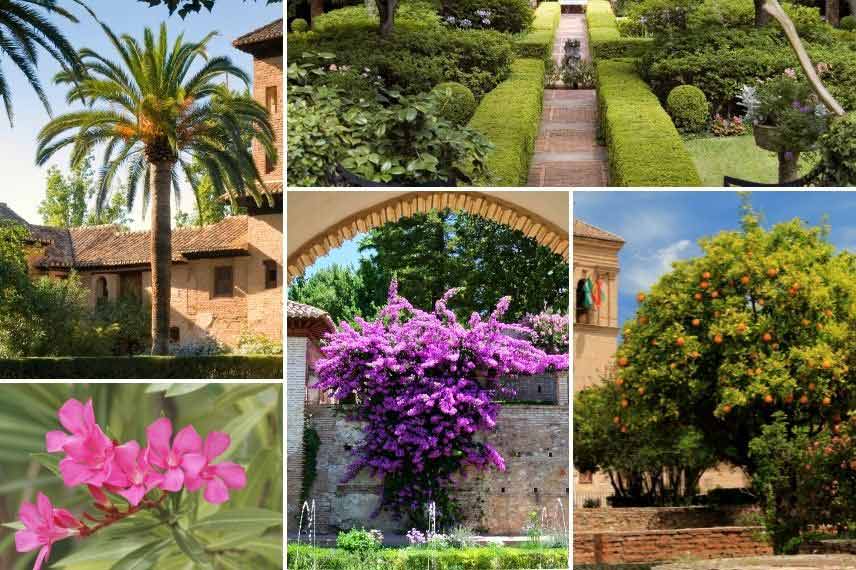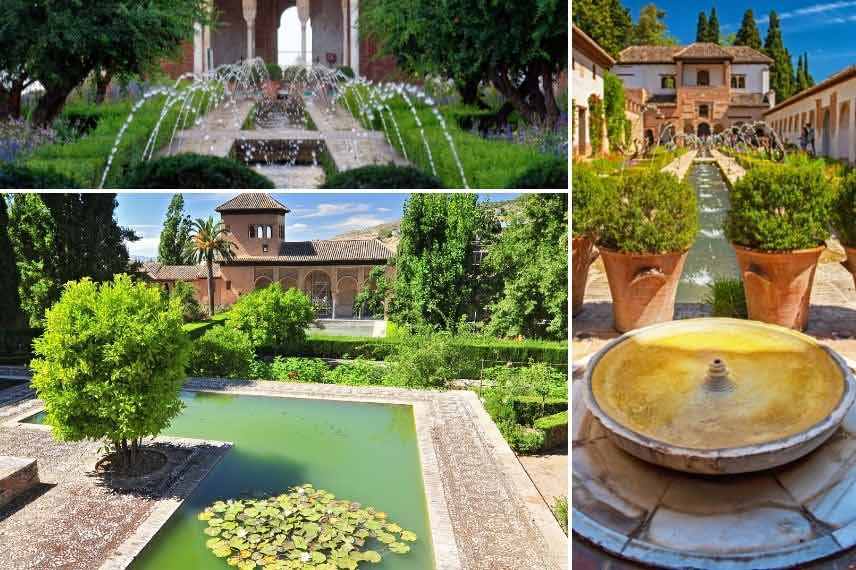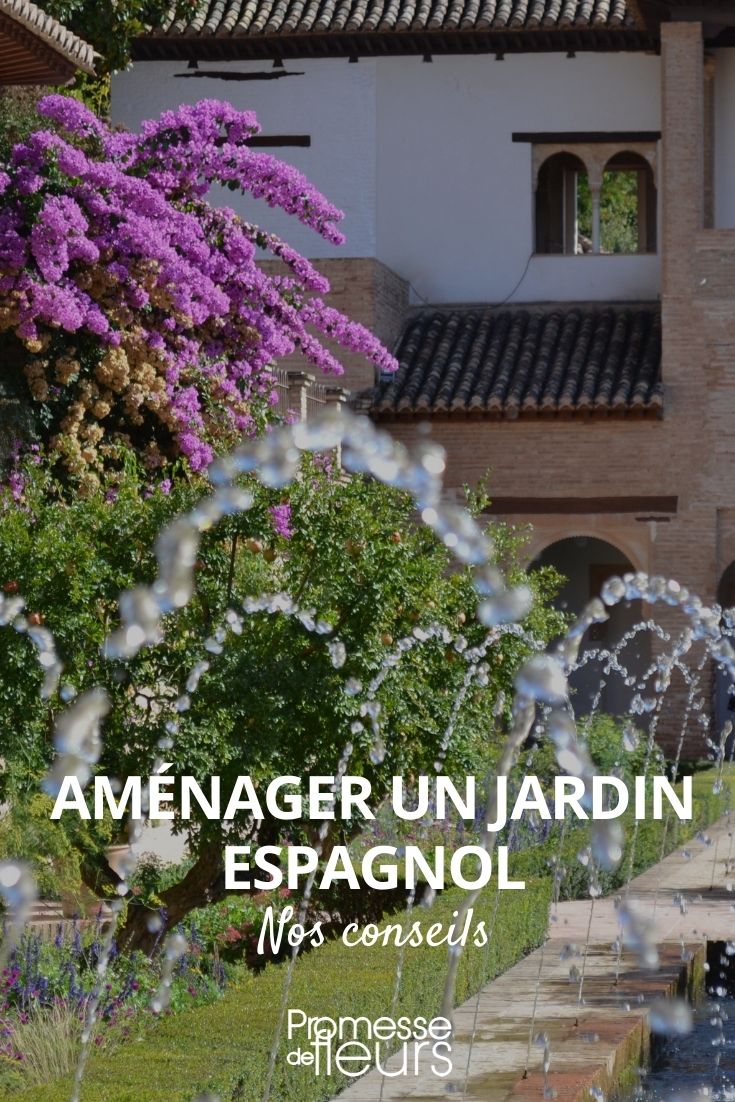
Designing a Spanish or Andalusian garden
Our tips for creating an Andalusian-inspired space
Contents
A wonderful blend of architecture and greenery, the Spanish or Andalusian garden evokes Paradise on Earth. The five senses are enchanted in these spaces: sight delights in the warm and vibrant hues of blooms balanced by lush greenery, hearing is soothed by the gentle sound of water from the fountains, smell is invigorated by the intoxicating scents of roses and jasmines. Touch explores the opulent foliage and discovers warm materials, while the taste buds are tantalised by the flavour of citrus trees and pomegranates…
Are you looking to create a space in this style, whether for a large garden, a patio, or an urban garden? Discover our tips for designing a Spanish or Andalusian garden worthy of the Alhambra!
The layout of the Spanish garden
The art of Andalusian gardens, showcased in the gardens of the Alhambra in Granada, Andalusia, is a type of landscaping inspired by Persian and Byzantine gardens. The Hispano-Arab garden appeals to all the senses to provide a glimpse of the ideal celestial garden spoken of by Muslims. Enclosed by walls—this configuration allows them to shelter both people and plants from the drying winds—they are created in opposition to the wild world that surrounds them. They often take on the appearance of patios with a soothing atmosphere. Water is one of the key elements of these Spanish gardens. It symbolises life, in the form of ponds, fountains, and channels. Finally, when it benefits from a view of the landscape, the Andalusian garden is enclosed by arcades and trellises in the form of mashrabiya, which help control the passage of the wind.
If you wish to embark on creating a garden of this type, here are the main elements to consider:
- Organise the space geometrically to create an intimate atmosphere of green enclaves. A patio or a walled garden are ideal configurations. These walls can be covered with white paint or ochre lime render. If your space is larger and open, define it with trimmed hedges and organise it into successive enclosures connected by geometric paths. Indeed, in Spanish gardens, open spaces are rare, as are uncovered paths, which are too exposed to the elements. Passionate about mathematics and geometry, the Arabs applied their knowledge in these areas to the art of gardens, resulting in skilful combinations of controlled shapes: square or rectangular spaces, straight paths intersecting at right angles, octagonal plazas.
- Choose terracotta-coloured floor coverings or light paving, which are very trendy.
- Opt for planting Mediterranean-type plants, selecting hardy species if your region experiences a somewhat harsh climate (citrus trees, palms, roses, boxwood borders, climbing plants).
- Pond or fountain: do not overlook the presence of water, which is essential in this type of garden.
- Awaken your layout with vibrant colours from pottery and glazed ceramics and/or the use of azulejos (decorated ceramic tiles).
 In a large garden, organise the space into a succession of enclosures connected by straight paths. In a smaller, walled space, recreate the atmosphere of patios with warm colours.
In a large garden, organise the space into a succession of enclosures connected by straight paths. In a smaller, walled space, recreate the atmosphere of patios with warm colours.
The plant palette of the Spanish garden
Hispano-Muslim gardeners had to adapt to challenging climatic conditions to create these lush spaces filled with greenery and flowers. The scarcity of water in these geographical areas and the strong sunlight led to a particular organisation, directly inspired by that of oases, namely the three-tiered garden with 3 plant strata, each protecting the others from the harshness of the sun and the drying winds:
The upper tier, for shade
- A tier of trees forming the shade layer dominates the garden: the foliage of these tall subjects protects the lower strata from the sun with welcome shade. This tier often features palms, cypresses, or cedars, showcasing evergreen foliage. These trees are arranged in symmetrically placed rows.
The middle tier, abundant with flowers and fruits
This middle tier is dedicated to fruit trees, flowering bushes and climbers:
- On the fruit side, citrus trees, which particularly enjoy warmth, are ideal: lemon trees, orange trees, or citron trees fill the air with their fragrant flowers and delight the taste buds, as we must remember that all senses are invited to the feast! Pomegranates thriving in the Mediterranean climate also have their place here, along with figs, jujubes, and almonds.
- For flowering bushes, we focus on reliable sun-loving varieties, such as oleanders, lagerstroemias, hibiscus, and roses, which can flourish with their exuberant and fragrant blooms, tempered by the dappled shade of the trees above them.
- Climbers such as jasmines, climbing roses, bougainvilleas, honeysuckles, and plumbagos enliven the walls with their vibrant flowers.
The lower tier, where water flows
The lower tier, closer to the ground, is primarily occupied by the element of water. Basins, fountains, and channels distribute it ingeniously while conserving and recycling it. The varied pavements and floor coverings (terracotta, ceramic, and marble), skillfully crafted, reflect a pleasant coolness, beneficial to both people and plants.
- On the plant side, boxwoods and myrtles trimmed low lend themselves admirably to topiary art and are valued for their great simplicity. They frame and highlight the basins and fountains.
- Flowering perennials, framed by the carefully trimmed borders, bring a controlled exuberance. Traditionally, you will find agapanthus, violets, flax flowers, lavender, chamomile, irises, or even pinks. Here, nothing prevents you from letting your inspiration run wild and playing with some colour combinations in harmony with the other elements of your layout (walls, flower colours of the bushes, furniture, and decorative elements). Opt for long-flowering and easy-to-care-for plants, such as bushy sages or gauras.
 Palms are part of the plant palette of the shade layer, while boxwoods and myrtles structure the space, and flowering bushes such as oleanders and climbers add a splash of colour. Don’t forget the sun-loving fruit trees, essential in these gardens dedicated to the 5 senses!
Palms are part of the plant palette of the shade layer, while boxwoods and myrtles structure the space, and flowering bushes such as oleanders and climbers add a splash of colour. Don’t forget the sun-loving fruit trees, essential in these gardens dedicated to the 5 senses!
Water: an essential element of the Spanish garden
In Andalusian gardens, water is ever-present. In Granada, Muslims channelled water from the surrounding mountains to irrigate their gardens and orchards, and to supply the pools and fountains of the Alhambra and the Generalife. If you don’t have the space or budget to create a pond, a small fountain beautifully showcased and well integrated into the style can do the trick. Find inspiration in Oliver’s tips for creating a small water garden for your terrace or balcony and adapt these ideas with lovely glazed ceramic pots for a guaranteed Andalusian effect!
 Stunning, water features and ponds are not within everyone’s reach. A beautiful ochre pot or basin (on the right) repurposed as a small pond or fountain will easily and affordably add an aquatic touch to your Andalusian garden.
Stunning, water features and ponds are not within everyone’s reach. A beautiful ochre pot or basin (on the right) repurposed as a small pond or fountain will easily and affordably add an aquatic touch to your Andalusian garden.
Read also
The best roses for Mediterranean climateMidrib decor
Reinforce the Spanish atmosphere of your garden with coherent decorative elements:
- The use of brightly coloured azulejos is a hallmark of Spanish-style gardens. A simple door and/or window frame enhanced with a frieze of these glazed ceramic tiles will immerse you in the ambiance
- Furniture can be made of wrought iron, and pottery in raw or glazed terracotta will complete the decor
- You can also use rectangular terracotta or glazed bricks to define planted areas and pathways.

Wrought iron furniture, bricks, and terracotta pots along with azulejos will add the finishing touch to a decor inspired by Spain
- Subscribe!
- Contents
































Comments